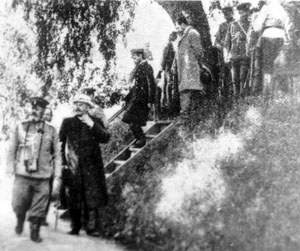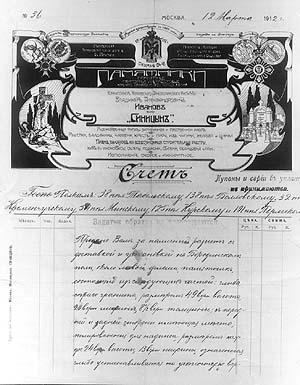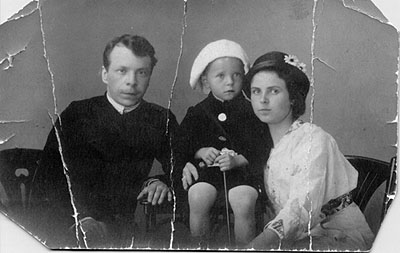From the history of the Borodino memorial
ALEXEY PAVLOVICH VERESCHAGIN
A year before the jubilee, at the end of August 1911, Alexey Pavlovich Vereschagin (born 18 March 1883) arrived at the Kochuginsky factory and was received by the senior technician-draftsman in the construction department of the factory. His arrival at the factory was not accidental. The experienced builder V. A. Pijotrovsky had departed from the factory. In the annual report to the board had been placed the question of increasing output of production and, correspondingly, skilled workers, and, of course, the required increase of housing construction.
On the recommendation of his colleague in the engineering company "Neptune", the Belgian Ambrose Emilievich Nicodeme also turned out to have been taken on for work in the construction department of the Kolchugin Company. His duties included design of the civil construction of the workers' housing. Before the visit to the Kelerovsky workers' housing, Alexey Pavlovich already had definite experience working out the design of construction projects. After the completion of his training, from 1906 to 1911 he worked as a draftsman of the office "Neptune" in the city of Moscow and participated in the design of projects of the water supply and the building of the urban area of the city of Moscow. While still a student in the Moscow College of Sculpture and Architecture, in the section of architecture in the senior design class, he became acquainted with V. A. Ivanov, who subsequently became the commissioner of the Moscow Archaeological Institute and the head of the firm "Sinitsin", which concerned itself with the making of monuments. Having received a serious order for a series of memorial obelisks for the centennial of the battle of Borodino, Vladimir Alexandrovich Ivanov began to select, on behalf of the clients, specialists from among the number of his acquaintances who might be able to execute the artistic design of the obelisks in a short time.
|
The jubilee commission already 21 December 1911 confirmed the general scheme of the placement of all of the memorials, built for the military units, which scheme remains to this day. Alexey Pavlovich received with gladness the invitation to participate in the creation of the historical obelisks to the fallen warriors and immediately departed to meet Ivanov, with whom he talked over all of the details of this serious and important business. The financial side of the affair was also decided, (very opportunely, as he had planned his wedding and wedding trip.) On his return to Kolchugino, he immediately set to work, since the time was very short.
|
For his work, A. Vereschagin received money from the Moscow Archaeological Institute, which was financing the work on the project. In the collections of the Military-Historical Museum of the Panorama "Borodino Field" is preserved an original document, Account No. 36 of 12 March 1912 to the clients/customers of memorials of the Fourth Infantry Division of Evgenii Wurtemburg, written in the hand of A. Vereschagin: "Sold to you for cash settlement on delivery to the Borodino field near the left fleche, a memorial, consisting of the following parts: a block of grey granite, measuring 49 vershok [215.6 cm] in height, 20 vershok [88 cm] in width, one vershok [4.4 cm] thick, with front and back sides having a place polished for inscriptions, each place measuring 24 vershok [105.6 cm] in height and 13 vershok [57.2 cm] in width. The aforesaid block was placed on the truncated height, 5 June 1912.".
Alexey Pavlovich in a short time created designs for eleven monuments. His next project was the memorial to the Second Cuirassiers Division of General {Duki}, then after that the Second Combined Grenadiers Division of General M. Voronstsov. Between them were the designs of the memorials to Murmonsky Infantry Regiment, to the Volynsky Infantry Regiment, and for the eleventh project, he finished the working-out of the memorial to the Second Cavalry Corps of Count K. K. Sievers.
The entire list of of memorial designs for the centennial of the battle of Borodino, worked out by A. P. Vereschagin, is as follows :

1. To the Pavlovsky Grenadiers Regiment.
|

2. To the Twenty-seventh Infantry Division of General Neverovsky.
|

3. To the Second Combined Grenadiers Division of General K. Mecklenberg and the Combined Grenadiers Division of General M. S. Vorontsov.
|

4. To the Second Cuirassiers Division of General I. M. Duki .
|
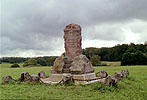
5. To the Murmonsky Infantry Regiment.
|

6. To the Volynsky Infantry Regiment.
|
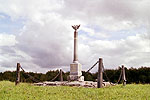
7. To the First Mounted Battery of Life Guards Artillery Brigade of Captain R. I. Zakharov.
|

8. To the Fourth Infantry Division of General E. Wurttemberg.
|

9. To the Twenty-fourth Infantry Division of General P. L. Likhachev.
|

10. To the Polevoy Mounted Artillery.
|

11. To the Fourth Cavalry Corps of General Sievers.
|

12. To the Cavalier-Guards and Horse-Guards.
|
Today we may see these monuments present on the "field of Russian glory." Under this title in 1979 appeared the book of O. Fedorova and V. Yshakov. On page 77 is written:
«... On the top of the hill stand little birches, grown up along the sides of the road. They seem to greet arrivals on the barrow, covering the memorials, various in form and color, located on the summit. In the middle of them stands out a monumental stele of black stone with polished places on its surface! This is the memorial to the Pavlovsky Grenadiers, built earlier than the others, in 1991 in the Moscow workshops of Ivanov. It is closest in style to the Kolchugin monuments, the work of A. P. Vereschagin.».
On p. 57 of the same book is the following note: "North-east of the former monastery, on the field, stands a slab of rose-colored granite, posterity's testimony of respect to the heroes of the Murmonsky Regiment, of the brigade of General A. A. Tuchkov. There are several memorials of similar form on the Borodino field. They obviously were executed by a single master craftsman, working in the Moscow workshop of V. A. Ivanov.".
It is possible that A.P. Vereschagin created a greater quantity of memorials as part of the project, but for the present, there is no documentary confirmation of them.
Thus was A. P. Versechagin, working as a draftsman, enamored of sculpture and architecture. Later he executed a memorial to the fighters for Soviet power for the city of Kolchugino of Vladimir Oblast (District), now dismantled).
Before the revolution of 1917, A. P. Vereschagin worked in the factory of the Kolchugin Company for the 20 months from August 1911 to April 1913 and was discharged by the manager Yu. P. Kliuch.
During this time, among his projects in the village of Berechin were built a private residence for T. P. Miatlev, the house of the engineer Obrecht (today the first children's playground of the factory "Electrocable"), and a wooden house, the private residence of the engineer Arkhereev (today the veterans' club). He participated in the design of the twenty-apartment building at No. 19 Lenin Street, and also of the buildings at No. 17 and No. 15.
From 1913 to 1916 Alexey Pavlovich worked in the city of Moscow in the Sheremetevsky company, whose office was located on Dolgorukov Street, No. 17.
This is what was written in the certificate given by this society and signed by its directory-manager Brazol.
Certificate: "This certifies that Alexey Pavlovich Vereschagin worked in our company from the beginning of its founding from 19 April 1913 to 8 March 1916, and took part in project planning and design of electrical tramways, water supply, sewer-system layout of city streets, etcetera. In all of his activities he completed his work to the highest degree of conscientiousness and with great capability and acumen. Moscow, 8 March 1916."
In the period from 1916 to 1921, he worked as a constructor in the city of Kazan at the powder factory, and then after that again transferred to work in the Kolchugin factory.
The certificate given by the factory manager of the First State Factory for Working of Non-Ferrous Metals makes the following note: "This is given to citizen Vereschagin Alexey Pavlovich for the reason that he was in service in the construction department of the First State Factory for the Processing of Non-Ferrous Metals in Kolchugino from 1921 to 1921 in the capacity of technician-draftsman. His responsibilities also comprised elaboration of details of projects for sanitary engineering and civil construction.".
In the first years after the revolution, A. P. Vereschagin was among those who laid the first stones to begin the rapid construction of workers' housing.
Here is a list of the objects, constructed in the Kolchugino workers' housing, as part of his projects and with his participation:
1. Water tower on October Street - 1921 (today in state of ruin)
2. Monument in memory of the fifth anniversary of October - 1922. (across from the Palace of Culture - demolished)
3. Wooden building of the workers' store on the settlement of Labor: 1923 (preserved)
4. Re-equipment of wooden barracks under the permanent industrial exhibition, its staging - 1924.
5. Design of the project of the office building - 1927 (today the managerial offices).
6. Design of the second wooden buildings on the Street of the Third International - 1926.
7. Design of projects and direction of construction of the central laboratory of the factory 1925 to 1927 (today Ts.L.Z).
8. Design of projects and participation in the construction of Dormitory No. 1 - 1926 (exists today on Lenin Street).
9. Design of the Muslim headstone of Mazar, of Uzbek labor, lost at the time of the construction of workers' housing in 1925, from the forties re-equipped under the transformer station - 1926 (today exists on the Street of the Third International).
10. Participation in the organization of the Kolchugin housing construction cooperative, and was a member of the board from 13 April 1925 to 1 April 1927. Working-out of designs, blueprints and estimates for the building of the Lenin settlement.
11. Design of Dormitory No. 2 for the workers' factory - 1927. Built in the Lenin settlement - exists today.
12. Design and construction of brick store for the workers' cooperative factory (Ts. R. K.), later called the "Central," on the Street of the Third International (today demolished).
Vereschagin had his workshop in the construction department, where he not only worked out various projects for sanitary engineering and civil construction, but also conducted studies in the contruction courses and led the training of craftsmen and skilled workers.
At the organization of the workers' high school and educational training center named after N. K. Krupskaya, A.P. Vereschagin was an instructor.
A. P. Vereschagin died in 1933 while on a business trip to the city of Moscow. He was buried on 6 July 1933 in the Preobrazhensky cemetery.
The wife of A. P. Vereschagin is buried in the city of Kolchugino, in the municipal cemetery. At the present time in our city, the son of A. P. Vereschagin, Stanislav Alexeevich, is still living. He possesses copies of the documents mentioned in this article.
